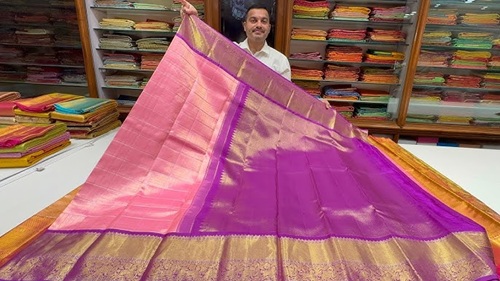Kanjivaram silk sarees, also known as Kanchipuram sarees, are one of the most prestigious handwoven textiles of India. Originating from Kanchipuram in Tamil Nadu, these sarees are celebrated for their lustrous silk, intricate zari work, and durability that makes them heirlooms passed down through generations. However, with their growing popularity and high demand, the market is flooded with imitations. To ensure that you are investing in an authentic Kanjivaram saree, it is important to understand how to identify a pure one.
1. Check the Silk Mark Certification

The simplest and most reliable way to confirm authenticity is the Silk Mark label issued by the Silk Mark Organization of India. Pure Kanjivaram silk sarees carry this certification, guaranteeing that the fabric is made of 100% pure silk and genuine zari. If a saree lacks this tag, buyers should proceed with caution.
2. Examine the Zari Work
One of the most striking features of a Kanjivaram saree is its zari (the golden or silver thread used in weaving borders and pallu).
- Pure zari is made with silver threads coated with gold, while imitation zari uses copper or polyester threads dipped in chemicals.
- To test, gently scratch the zari thread: if red or coppery tones appear underneath, it is not pure. Pure zari will reveal a silver base beneath the golden coating.
3. Look for Contrast Borders and Pallu
Authentic Kanjivaram sarees are woven with a unique technique called “korvai,” where the body of the saree and the border/pallu are interlocked separately. This creates a strong contrast between the body and borders, often in rich shades. Fake sarees may simply be printed or stitched, which is easier and cheaper.
4. Check the Weight and Texture
Kanjivaram sarees are known for their heaviness and durability. Pure mulberry silk, used in these sarees, gives them a rich, smooth texture and significant weight compared to synthetic imitations. A real Kanjivaram feels soft, yet firm, and drapes gracefully without being flimsy.
5. Test the Silk by Touch and Burn Method
- Touch Test: Pure silk feels warm when rubbed between your fingers, unlike synthetic fibers, which remain cold.
- Burn Test (with caution): If you carefully burn a loose silk thread, pure silk will emit a smell similar to burnt hair and turn into black ash. Fake silk, however, melts and produces a plastic-like odor.
6. Inspect the Weaving Patterns
Kanjivaram sarees often depict motifs inspired by temples, peacocks, elephants, or mythological stories. These motifs are woven, not printed. If you see printed designs, it is not genuine. Handwoven Kanjivarams also show slight irregularities, proving they are handmade.
7. Check the Price Factor
A pure Kanjivaram silk saree is expensive because it involves intricate handweaving, pure mulberry silk, and genuine zari. The cost usually starts from ₹10,000 and can go up to lakhs, depending on the intricacy. If the saree is offered at a very low price, it is most likely fake or blended with synthetic fibers.
8. Durability and Legacy
A hallmark of pure Kanjivaram sarees is their longevity. With proper care, these sarees can last for decades without losing their shine. Many families pass them on as heirlooms, something that is rarely possible with imitations.
Final Thoughts
Owning a pure Kanjivaram silk saree is not just about fashion—it is about preserving India’s rich handloom tradition. By checking the silk mark label, examining zari work, feeling the texture, and understanding weaving techniques, buyers can confidently distinguish between genuine and imitation sarees. Since these sarees are often a lifelong investment, taking time to authenticate them ensures you carry a piece of timeless tradition with pride.